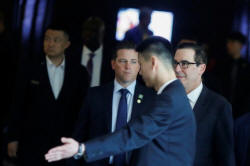China, U.S. reach some deals in trade row but Beijing
says differences still relatively big
 Send a link to a friend
Send a link to a friend
 [May 04, 2018]
By Sue-Lin Wong and Elias Glenn [May 04, 2018]
By Sue-Lin Wong and Elias Glenn
BEIJING (Reuters) - Top officials from
China and the United States reached a consensus on some aspects of the
countries' trade row, but disagreements over other issues remain
"relatively big", China said on Friday.
A statement from the nation's state-run Xinhua news agency at the end of
the talks gave little indication that there had been agreements on the
biggest issues, stressing instead that there had been exchanges of
opinion. The two sides, though, committed to resolving their trade
disputes through dialogue, Xinhua said.
The Americans have yet to give their account of the talks.
In one specific sign of progress, U.S. negotiators agreed to bring up
with U.S. President Donald Trump the question of a ban on U.S. companies
selling goods and software to Chinese telecommunication equipment maker
ZTE Corp after representations from the Chinese side, the report said.
ZTE faced the seven-year ban after the U.S. said it failed to keep to an
agreement it made after breaching U.S. sanctions.

The talks over the past two days have involved a high-level U.S. trade
delegation led by Treasury Secretary Steven Mnuchin and top Chinese
officials, including Vice Premier Liu He, following months of threats
and counter threats from both sides in a series of disputes over trade
practices.
The U.S. team has already left Beijing and is heading back to the U.S.,
a U.S. official told Reuters early on Friday evening.
The trade discussions had been "candid, efficient and constructive,"
Xinhua said, but gave almost no details on what the officials had
agreed.
The officials exchanged opinions on resolving tariffs and non-tariffs
measures, on expanding two-way investment and the protection of
intellectual property, and on expanding U.S. exports to China and
bilateral services trade, Xinhua reported. It gave no indication of what
actions might be taken based on those exchanges.
"My impression was that (the talks) didn't go well given the rhetoric,"
said Kevin Lai, senior economist at Daiwa Capital markets in Hong Kong.
"I think the divide is still very big."
In an editorial on its website, widely-read Chinese state-run tabloid
the Global Times cited people close to the talks as saying the Chinese
"hit back hard" at U.S. criticism, letting them know that China won't
give in.
The United States has proposed tariffs on $50 billion of Chinese goods
under its so-called "Section 301" intellectual property probe. Those
could go into effect in June following the completion of a 60-day
consultation period, but activation plans have been kept vague.

China has said its own retaliatory tariffs on U.S. goods, including
soybeans and aircraft, will go into effect if the U.S. duties are
imposed.
The U.S. tariffs focus heavily on technology products benefiting from
the "Made in China 2025" programme, which promotes the development of 10
sectors including aerospace, robotics and clean-energy cars.
PUNITIVE ACTION
A breakthrough deal to fundamentally change China's economic policies
was viewed as highly unlikely during the two-day visit, though any signs
of meaningful progress in the dispute could delay any punitive action
from the U.S.
"We are having very good conversations," Mnuchin told reporters earlier
on Friday as he left his hotel.
U.S. President Donald Trump on Thursday praised his relationship with
Chinese President Xi Jinping as the U.S delegation began their talks,
which were held at a state guest house in the western part of the
Chinese capital.
Trump has targeted China's massive trade surplus with the United States,
in recent months demanding a $100 billion annual reduction in the $375
billion U.S. goods trade deficit with China.
[to top of second column] |

U.S. Treasury Secretary and member of a U.S. trade delegation Steven
Mnuchin leaves a hotel in Beijing, China, May 4, 2018.
REUTERS/Thomas Peter

According to two sources with knowledge of the matter, the U.S. delegation
submitted a document to the Chinese before the talks asking China to cut its
trade surplus with the United States by $200 billion by 2020 and lower tariffs
on all products to levels no higher than those imposed by the United States.
The delegation also asked China to halt subsidies for advanced technology, the
sources said.
Chinese officials believed the proposal was "unfair," the Wall Street Journal
reported, quoting people with knowledge of the negotiations.
"I think the U.S. is asking for the impossible. Reducing the deficit by $200
billion by 2020 is quite an unrealistic demand, but it may also be a negotiation
tactic to start high first," said Tommy Xie, economist at OCBC Bank in
Singapore.
In a proposal submitted by the Chinese side, Beijing offered to increase U.S.
imports and lower tariffs on some goods, including cars, according to the
sources. [S6N1RF058]
But China requested that the U.S. treat Chinese investment equally under
national security reviews, stop issuing any new restrictions on investment, and
halt a proposal to implement 25 percent tariffs under its Section 301 probe.
China also offered to reconsider anti-dumping duties on U.S. sorghum, according
to the proposal.

NO ILLUSIONS
U.S.-based trade experts have said they expected Beijing to offer Trump's team a
package of policy changes that may include some previously announced moves, such
as a phase-out of joint venture requirements for some sectors, autos tariff
reductions and increased purchases of U.S. goods.
U.S. complaints about Chinese intellectual property abuses are at the core of
the current dispute. The Trump administration says U.S. companies lose hundreds
of billions of dollars annually to China's theft of trade secrets.
Members of the Trump administration's delegation to Beijing for talks to try to
stave off a trade war between the world's two largest economies included U.S.
Trade Representative Robert Lighthizer, a hard-line and experienced trade
negotiator.
Lighthizer said on Tuesday it was not his objective to change China's economic
system, but that he would try to find ways to limit the damage it causes to the
United States and open it further for U.S. companies.
Some economists noted that the deficit with China was the natural result of the
large amount of manufacturing assembly of U.S. products, such as iPhones, that
takes place in China.
"As long as China remains the assembly hub of the world, it's always going to
have a large trade surplus with developed consumer countries like the U.S. and
the E.U. and that's not necessarily a problem," said Julian Evans-Pritchard,
senior China economist at Capital Economics.
The U.S. delegation also included Commerce Secretary Wilbur Ross and White House
trade and manufacturing adviser Peter Navarro, a noted China trade hawk.
Navarro advised Trump throughout his 2016 election campaign, during which the
candidate routinely threatened to impose a 45 percent across-the-board tariff on
Chinese goods as a way to level the playing field for American workers.
(Reporting by Sue-Lin Wong and Elias Glenn. Additional reporting by Michael
Martina, Shu Zhang, Kevin Yao and Philip Wen in BEIJING and Adam Jourdan in
SHANGHAI. Writing by Ben Blanchard and Ryan Woo.; Editing by Lincoln Feast and
Martin Howell)
[© 2018 Thomson Reuters. All rights
reserved.] Copyright 2018 Reuters. All rights reserved. This material may not be published,
broadcast, rewritten or redistributed.
Thompson Reuters is solely responsible for this content. |